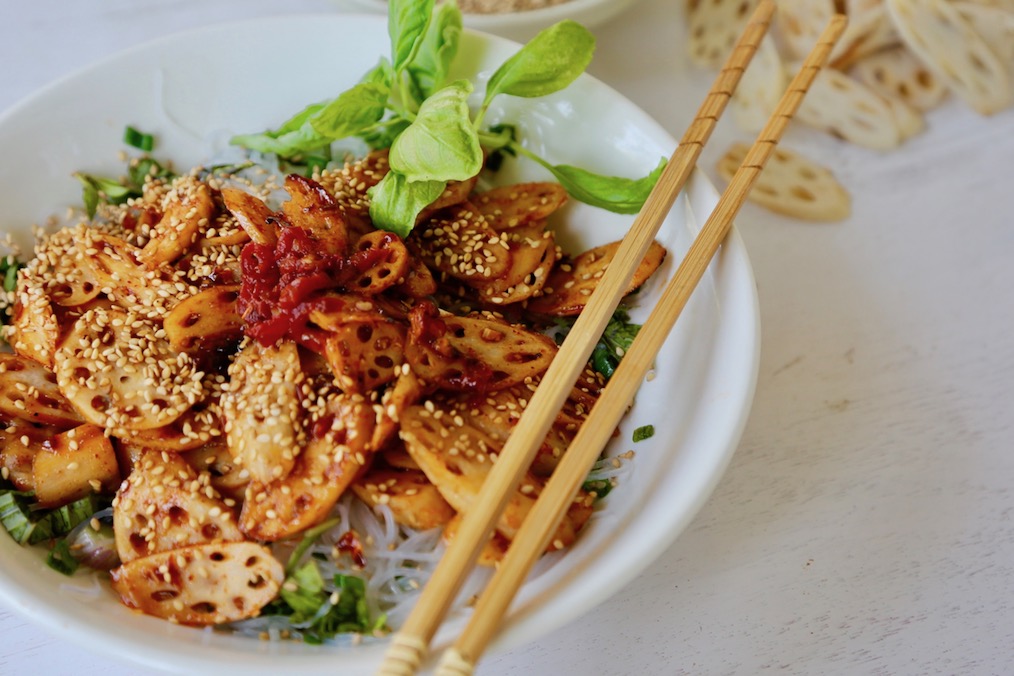
India’s national flower is the lotus, so it not surprising that one of its culinary gems amongst ingredients is the lotus stem. These modified stems, technically known as rhizomes, are often also called lotus “roots”. In reality, the lotus plant has small roots that are embedded in the muddy soil of a pond.

It is not just the stem of lotus plant that is delicious, but both the leaves and the seeds are eaten as well. In India we often eat the roasted “popped” seeds –known as makhana in Hindi – as a spiced snack, in curries and even in yoghurt. Check out my easy and popular Lotus Seeds in Yoghurt recipefor an quick dish with popped lotus seeds.

As lotus grows in murky, swampy water, the stems often harbor parasites from their environment. It is best to steam or fry the stems before using them in salads. Older stems can be tough and also require some pre-cooking.

Lotus stems are crunchy, high in dietary fiber, low in saturated fats and loaded with healthy B Complex vitamins and minerals. More importantly, from the culinary point of view, lotus stems make for a highly aesthetic ingredient. The hollow tubes in the stem leave the slices with beautiful holes in them, adding to their quintessential appeal.
If you haven’t eaten lotus stem – and I am always surprised, having grown up in South East Asia where they are commonly found, by how many people haven’t – it is similar in taste to the crunchy, raw water chestnut. Slightly bland, crisp, with a fibrous texture and the lack of any dominating flavour, like tofu, it takes on the taste elements of any sauce or ingredients it is cooked in.
I’m a fan of this unsual “vegetable”, once common in Indian cuisine but becoming more rare. Below is an easy recipe you can impress your friends with – simple to make, with lovely colour and exciting flavour!

Caramelized Garlic-Chili Lotus Stem and Moong Bean Noodles
Ingredients
3 medium sized fresh lotus stems, peeled (about 300g)
6 cloves garlic, minced
4 tablespoons mildly hot red chilies
1½ tablespoons vinegar
1½ teaspoons salt – divided
2 tablespoons brown sugar
½ teaspoon paprika (optional – for colour)
2 green onion stalks, finely chopped
6 basil leaves, torn into smaller pieces
50g moong bean noodles
1 teaspoon sesame oil
3 teaspoons sesame seeds, lightly dry roasted
2½ tablespoons corn or safflower oil
Method
Slice lotus stem into thin slices along the diagonal. Steam for 5-7 minutes minutes until cooked through.
Soak moong bean noodles as per direction in hot water for 2-3 minutes. When soft toss with ½ teaspoon salt, sesame oil and add green onions and basil and put in serving bowl.
Combine garlic, red chilies and vinegar in a small food processor and process until you get a bright red paste.
Heat the remaining oil in a 6” frying pan. Add garlic-chili paste. Stir-fry for 1 minute.
Add lotus stem pieces and remaining 1 teaspoon salt. Stir-fry for 2-3 minutes until nicely coated with garlic chili mixture. If you would like a “redder’ finish, add paprika.
Add soya sauce and brown sugar stir-fry for 2-3 minutes or until lotus pieces are nicely caramelized and slightly browned.
Place lotus stem pieces on prepared moong bean noodles. Garnish with roasted sesame seeds.
Serve immediately.
Serves: 4, as a side
Ingredients: 13
Critical Ingredients: Lotus root is unique in flavour and texture and is basic to this recipe. Use the freshest root you can find, which is not very fibrous. You can substitute Kashmiri chili powder for paprika. Basil can be substituted with fresh coriander.
If you enjoyed this recipe, and want to try another creation using lotus stems, a low-oil recipe is Crispy Lotus Root Pepper Salt pictured below, with the incredibly pungent, peppery and numbing flavour of Szechuan pepper.





